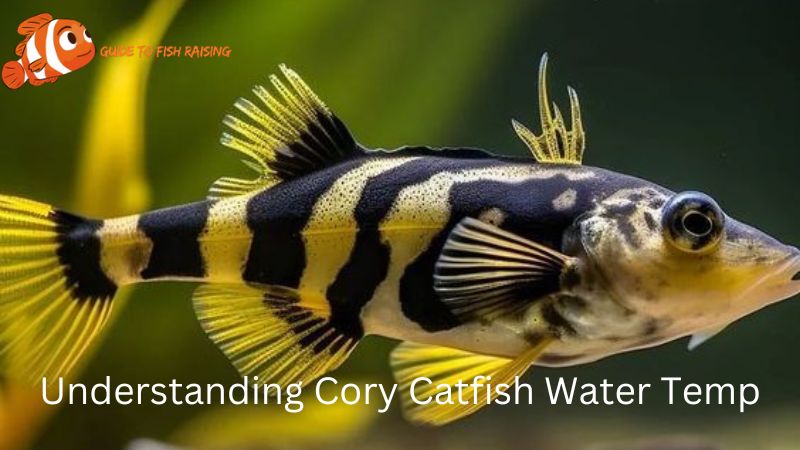Corydoras catfish, commonly known as cory catfish or simply corys, are popular freshwater aquarium fish admired for their peaceful nature, social behavior, and unique appearance. Native to South America, these catfish species thrive in well-maintained aquarium environments with specific water temperature conditions that mimic their natural habitat. This article Guide to Fish Raising explores the importance of Cory Catfish Water Temp, optimal temperatu
Table of contents
ToggleImportance
Maintaining the right water temperature is critical for the health and well-being of cory catfish. Like all fish, corys are ectothermic, meaning their body temperature fluctuates with the temperature of their surroundings. Temperature directly influences their metabolism, immune system function, behavior, and overall physiological processes. Therefore, understanding their temperature requirements is essential for keeping them thriving in captivity.
Optimal Cory Catfish Water Temp
Cory catfish are typically found in tropical freshwater habitats, preferring stable water temperatures that range between 72°F to 78°F (22°C to 26°C). Within this range, they exhibit optimal health, activity levels, and breeding behaviors. However, some species within the Corydoras genus may tolerate slightly cooler temperatures down to 70°F (21°C), while others may prefer temperatures closer to 80°F (27°C), depending on their specific natural habitat adaptations.
Factors Influencing Temperature Preferences
Corydoras catfish, known for their charming appearance and peaceful demeanor, are native to various freshwater habitats across South America. Understanding the factors that influence their temperature preferences is crucial for creating a suitable environment in captivity that supports their health, behavior, and overall well-being. Here’s a detailed look into
Species Specificity
Cory catfish encompass a diverse group within the Corydoras genus, with over 170 recognized species. Each species has evolved to thrive in specific environmental conditions dictated by their native habitats. As a result, their temperature tolerance
Variability in Temperature Tolerances:
- Cooler Water Species: Some cory catfish species, like Corydoras paleatus (Peppered Cory), originate from cooler waters. They tend to prefer temperatures towards the lower end of the spectrum, often thriving in aquariums maintained between 70°F to 75°F (21°C to 24°C).
- Warmer Water Species: Conversely, species such as Corydoras aeneus (Bronze Cory) are adapted to warmer waters and may prefer temperatures ranging from 75°F to 80°F (24°C to 27°C).
Understanding the specific temperature preferences of the cory catfish species you keep is essential for providing an environment that promotes their health and natural behaviors.
Geographic Origin
Cory catfish are indigenous to diverse freshwater environments throughout South America, including rivers, streams, floodplains, and tributaries. These habitats exhibit varying temperature profiles influenced by local climate, altitude, and seasonal changes.
Regional Temperature Variations:
- Amazon Basin: Species originating from the Amazon River and its tributaries experience relatively stable, tropical temperatures year-round. Water temperatures in these regions often range between 75°F to 80°F (24°C to 27°C), supporting a rich biodiversity of aquatic life, including cory catfish adapted to warmer conditions.
- Andean Highlands: In contrast, cory catfish found in higher altitude regions, such as the Andean foothills, may experience cooler water temperatures due to mountain runoff and seasonal fluctuations. These species may thrive in aquarium setups with slightly cooler temperatures around 70°F to 75°F (21°C to 24°C).
Seasonal Variations
In their natural habitats, cory catfish encounter seasonal changes in water temperature corresponding to local climatic conditions. Mimicking these natural fluctuations in captivity can promote natural behaviors, reproductive cycles, and overall well-being.
Winter and Summer Patterns:
- Cooler Seasons: During cooler months or dry seasons, water temperatures in natural habitats may slightly decrease. This seasonal variability influences the metabolic rates and activity levels of cory catfish, prompting adjustments in feeding habits and energy expenditure.
- Warmer Seasons: Conversely, warmer seasons bring higher water temperatures, stimulating breeding behaviors and increased activity among cory catfish species adapted to these conditions.
Replicating these seasonal temperature patterns in your aquarium, such as adjusting heater settings seasonally or providing a temperature gradient, can support the natural rhythms and biological processes of cory catfish kept in captivity.
Tank Mates
Compatibility with tank mates is another crucial factor influencing the temperature preferences of cory catfish. These social and peaceful fish are often kept in community aquariums alongside other tropical fish species that share similar temperature requirements.
Harmonious Temperature Needs:
- Tropical Community Fish: Cory catfish are commonly housed with other tropical species like tetras, rasboras, and gouramis, which also thrive in stable water temperatures ranging from 72°F to 78°F (22°C to 26°C).
- Avoiding Temperature Extremes: Ensuring compatibility among tank mates prevents conflicts arising from temperature disparities and promotes a harmonious environment conducive to the well-being of all aquarium inhabitants.
Practical Tips for Maintaining Stable Water Temperature

Achieving and maintaining stable water temperature conditions in your aquarium is vital for the health and longevity of cory catfish. Here are practical tips to ensure optimal temperature stability:
Choose a Quality Aquarium Heater
Investment in Reliability: Select an aquarium heater that matches the size of your tank and provides consistent heating. Opt for heaters with built-in thermostats to regulate temperatures automatically within the desired range, typically between 72°F to 78°F (22°C to 26°C) for cory catfish.
Heater Capacity: Ensure the heater’s wattage is appropriate for your aquarium size to efficiently maintain stable temperatures. Consider using a secondary heater or a higher-capacity unit for larger tanks to evenly distribute heat.
Strategic Thermometer Placement
Multiple Thermometers: Place thermometers at different locations within the aquarium, such as near the heater, at opposite ends of the tank, and near the water surface. This placement helps monitor temperature variations and ensures uniform heating throughout the tank.
Calibration: Regularly calibrate thermometers to maintain accuracy in temperature readings. Verify readings with each thermometer to confirm consistent measurements across the tank.
Regular Temperature Monitoring
Routine Checks: Monitor water temperature daily, especially during seasonal changes or extreme weather conditions that may affect room temperatures. Establish a habit of checking temperatures at the same time each day to detect deviations promptly.
Manual Verification: Cross-check automated thermostat readings with manual thermometer readings to confirm accuracy and identify any discrepancies that may indicate heater malfunction or calibration issues.
Establishing a Temperature Gradient
Strategic Placement: Position the aquarium heater near the water flow source, such as the filter outlet or circulation pump, to create a gentle temperature gradient. This setup helps distribute heated water evenly throughout the tank, preventing localized temperature fluctuations.
Aquarium Layout: Arrange tank decorations and plants to create natural barriers that encourage water circulation and temperature balance. Avoid blocking the heater or restricting water flow, which can disrupt temperature distribution.
Minimize Temperature Shocks
Acclimation Process: During water changes or when introducing new fish, acclimate them gradually to avoid temperature shocks. Float the quarantine or transport bag in the aquarium water for 15-30 minutes to allow water temperatures to equalize slowly.
Slow Integration: When adjusting heater settings or performing maintenance that affects water temperature, make gradual changes over several hours to minimize stress on cory catfish and other tank inhabitants.
Monitor Room Temperature Variations
Environmental Factors: Consider how ambient room temperatures fluctuate throughout the day and across seasons. Adjust aquarium heater settings accordingly to maintain consistent water temperatures that align with the natural preferences of cory catfish.
Insulation and Protection: Use heater guards or insulating sleeves to protect heaters from external temperature influences and prevent heat loss. Maintain adequate ventilation around the aquarium to regulate internal temperatures effectively.
Common Temperature-Related Issues and Solutions
Maintaining stable water temperatures is crucial for the health and well-being of cory catfish. Sudden fluctuations or incorrect temperature settings can lead to stress, compromised immune systems, and increased susceptibility to diseases. Here’s a detailed exploration of common temperature-related issues encountered in aquariums housing cory catfish, along with practical solutions to ensure optimal conditions for these beloved freshwater fish.
Temperature Fluctuations
Issue: Rapid changes in water temperature within the aquarium environment can significantly impact cory catfish, causing stress and potential health problems. Factors such as inadequate heating equipment, environmental changes, and improper maintenance can contribute to temperature fluctuations.
Solution:
- Use of Reliable Heater: Invest in a high-quality aquarium heater appropriate for your tank size. Select a heater with a built-in thermostat to maintain stable temperatures within a narrow range, typically set between 72°F to 78°F (22°C to 26°C) for most cory catfish species.
- Regular Monitoring: Monitor water temperature daily using a reliable thermometer placed in a central location within the tank. This practice helps you detect any deviations from the desired temperature range promptly.
- Room Temperature Considerations: Avoid placing aquariums near sources of temperature fluctuation, such as direct sunlight, drafty windows, or heating/cooling vents. These factors can influence water temperature unpredictably and stress your fish.
Heater Malfunctions
Issue: Malfunctioning aquarium heaters can lead to sudden temperature drops or spikes, posing a significant risk to cory catfish and other aquarium inhabitants. Common causes of heater malfunctions include electrical failures, thermostat inaccuracies, and wear over time.
Solution:
- Routine Maintenance: Regularly inspect and clean aquarium heaters according to manufacturer guidelines. Ensure the heater is securely installed and submerged to the recommended water level to prevent overheating or exposure during water changes.
- Backup Heater: Keep a spare heater on hand as a precautionary measure against potential malfunctions. A backup heater ensures continuity of stable water temperatures in the event of primary heater failure, minimizing stress on your fish.
- Thermostat Calibration: Periodically calibrate the thermostat on your heater to verify accuracy. Use a separate thermometer to cross-check water temperature readings and adjust settings as needed to maintain consistency.
Seasonal Adjustments
Issue: Seasonal changes in ambient room temperatures can affect the water temperature in your aquarium, necessitating adjustments to maintain optimal conditions for cory catfish.
Solution:
- Temperature Monitoring: During colder months, monitor room temperatures regularly and adjust the aquarium heater settings accordingly to compensate for cooler ambient conditions. Aim to maintain a stable water temperature consistent with your cory catfish’s preferences.
- Use of Heater Guards: In homes where room temperatures fluctuate significantly, consider using heater guards or insulating sleeves around aquarium heaters to stabilize water temperatures and prevent heat loss.
- Heating in Summer: In warmer seasons, reduce the heater settings or turn off the heater if room temperatures naturally elevate above the preferred range for cory catfish. Ensure adequate water circulation and ventilation to prevent overheating.
Conclusion
Maintaining optimal water temperature is fundamental to the health and well-being of cory catfish in your aquarium. By understanding their natural habitat preferences, investing in quality equipment, and implementing proper temperature monitoring and maintenance practices, you can create a stable and comfortable environment where cory catfish thrive. Remember, consistency in temperature management is key to ensuring these delightful fish exhibit their natural behaviors and remain healthy and vibrant in captivity.





